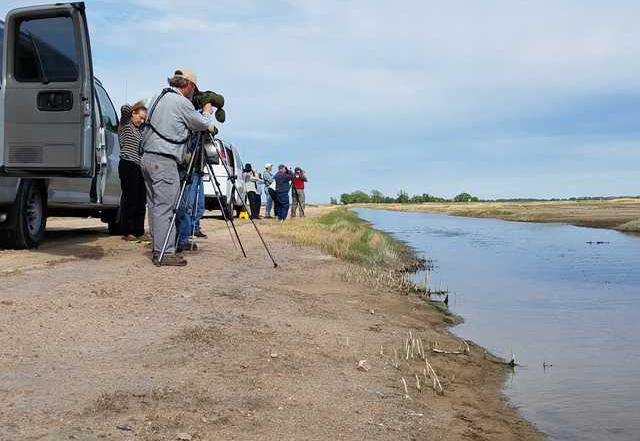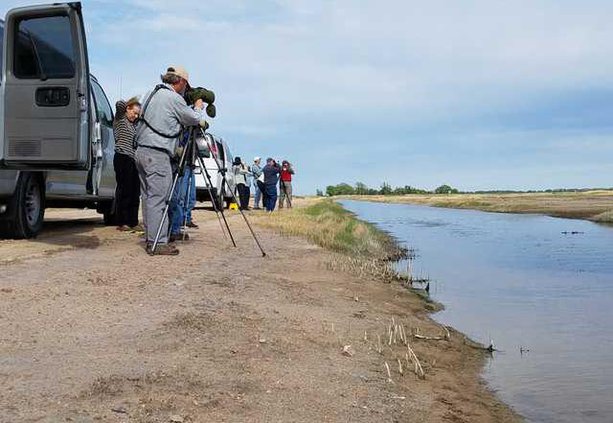At the 2017 Wings ‘N’ Wetlands Birding Festival, the emphasis Saturday was on WET. But rain and temperatures in the low 40s didn’t stop birdwatchers from across the nation from touring central Kansas this past weekend.
Birders traveled from as far away as Oregon and North Carolina for this festival, which is held every other year. Cheyenne Bottoms falls square in the midst of the Central Flyway, making it nature’s equivalent to a sky interstate for migrating birds, according to information from the Kansas Wetlands Education Center. With more than 41,000 acres in the Cheyenne Bottoms Basin and more than 28,000 acres managed by Kansas Department of Wildlife and Parks and the Nature Conservancy, Cheyenne Bottoms is the largest wetland in the interior of the United States.
“The main focus of the festival is the birding field trips to Cheyenne Bottoms and Quivira National Wildlife Refuge,” said Curtis Wolf, director of the Kansas Wetlands Education Center. “However, there are other opportunities for participants to explore local attractions and the Wetlands & Wildlife National Scenic Byway.”
By the time the two-day festival got underway Friday, 83 participants from 17 states had registered. Friday was warmer and dryer, but Saturday’s weather provided some unusual opportunities.
“We were getting really good looks at the shore birds,” Wolf said. “It was kind of an interesting phenomenon with the rain; they were by the side of the road feeding on insects and worms.”
Maggy Linka from Greensboro, N.C., said she enjoyed the field trips in spite of the weather. “We birders are hearty people,” Linka said.
“I’ve been to Kansas twice before but this was my first time to attend the festival,” she said. “I chose this festival because I did not know a lot of wetland birds.” Linka said she met birders from all over the country during the festival.
Michael Donnelly made the trip from Manhattan. “I was here two years ago and thought it was a great event,” he said. This year he returned with his wife. Thanks to the change in weather, he said, “we saw thousands of swallows.” They also saw avocets catching worms in the middle of the road.
There was also plenty to do indoors. Program presenters included nature photographer Bob Gress, Milford Nature Center Director Pat Silovsky and KWEC Educator Pam Martin.
On Saturday afternoon, Silovsky and Martin brought live hawks and owls for a talk about birds of prey. When a raptor — that is, a bird of prey — cannot be released into the wild because it is injured or has become habituated to captivity, it may become a permanent resident of Milford or another rehab center. One of the “bird ambassadors” that Martin takes to programs is Thurston, a great horned owl owned by the Great Bend Brit Spaugh Zoo.
“Raptors are fierce but they’re charming at the same time,” Martin said.
Silovsky said an eagle can spot a fish from a mile away. “If an eagle could read the newspaper, it could read the headlines from a block away,” she said.
Raptors help humans by eating mice and insects, Silovsky said. Turkey vultures and black vultures are scavengers, more closely related to storks but still considered raptors, and they also have an important role in nature. While injured birds can be taken to a facility that has raptor rehabilitation, including the Great Bend Zoo, Silovsky stressed, “The best way to help an animal (usually) is to leave it alone.”
The festival was sponsored by the Kansas Wetlands Education Center, which is overseen by Fort Hays State University; Kansas Department of Wildlife Parks & Tourism; The Nature Conservancy and the City of Great Bend.





